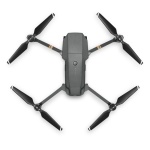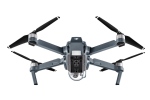Let us begin with an introduction to the modern-day drone. Though many drones of all shapes, sizes, propeller arrangements, and sensors exist in our world today, I want to narrow our focus to one drone and use this to lay down a base foundation of the engineering and design that goes into today’s consumer drones. As we delve deeper into the workings and applications of drones in later articles, we will begin to talk about the different designs and adaptations made from the base design that allows for specialised drones designed for specific tasks. For the sake of the reader, we will begin to look at one of the latest drones from the leading consumer drone company DJI, The Mavic Pro. This drone has more than the basics features required for a drone but, embodies what most modern consumer drones strive for.
This drone features four independent high RPM brushless motors, a 3-axis gimbal equipped with a 4k camera capable of shooting up to 120FPS at 720p and 30 in 4K, front and underside visual object avoidance systems, lithium ion high capacity batteries capable of a twenty-seven minute flight times, GPS and Glanoss location systems, computer vision tracking systems managed by Intel’s Modivius computer vision and deep learning system, and a folding design allowing the drone to fold down to a size of 83mm x 83mm x 198mm in a matter of seconds.
This drone has all the basics of the modern-day drone: GPS, 4K camera, Gimbal stabilization, high capacity batteries, brushless electric motors, and more. This drone is also equipped with some extra bells and whistles that make this drone a good base to focus on. Over the next few posts, I will elaborate on some of these features and explain their purpose, design, and why they are a staple of today’s modern drone. In later posts, I will also elaborate on the advanced features this drone possesses and how they are specialized to the consumer market. The pictures provided demonstrates a top, bottom, side, and folded view of the drone so that the reader may have a visual aid to follow along with.
- GPS/Glanoss location tracking
- Stabilization systems (Gimbal and Drone)
- 4k camera
- Batteries
- Brushless motors
- Object avoidance (not a necessity but allows for better flying. )
- 4 arm design.
Links to other posts:
The Specialisation of drones
The Consumer market
Military
Competition
Work, Construction, and shipping
Promotional Use
Small business
Sources:
http://www.drone-world.com/dji-mavic-pro-specs (General specs)
http://www.dji.com/mavic/info#specs (DJI specs)
http://www.dji.com/newsroom/news/inside-a-drone-brushless-motors (brushless motors explained)




